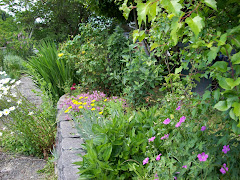 April begins a new year in the garden. The daffodils and hyacinths have come and gone, and the tulips are in their glory. This week our phlox erupted in beautiful purple flowers, and the first blossoms emerged on our dwarf Fuji apple tree. The Olympia Farmers Market has opened, and I have already purchased a wonderful new plant there, a Kinkaku Japanese tree peony from the Lilly Pad. It is only a one-year graft so I should have fun watching it develop over the next couple years.
April begins a new year in the garden. The daffodils and hyacinths have come and gone, and the tulips are in their glory. This week our phlox erupted in beautiful purple flowers, and the first blossoms emerged on our dwarf Fuji apple tree. The Olympia Farmers Market has opened, and I have already purchased a wonderful new plant there, a Kinkaku Japanese tree peony from the Lilly Pad. It is only a one-year graft so I should have fun watching it develop over the next couple years.Our prolific neighborhood weeds have also emerged. Rather than hoeing and pulling, I am using the spaghetti garden method of smothering them with old paper grocery bags, newspaper, and bark.
 This doesn't completely eliminate traditional weeding, but it cuts down on it considerably. Over time this method should improve the overall soil quality by adding organic matter instead of taking it away. I am a little concerned about pH levels as all of these materials are acidic. I am planning to add lime as a counterbalance, but, if anyone has any better ideas, please feel free to share them.
This doesn't completely eliminate traditional weeding, but it cuts down on it considerably. Over time this method should improve the overall soil quality by adding organic matter instead of taking it away. I am a little concerned about pH levels as all of these materials are acidic. I am planning to add lime as a counterbalance, but, if anyone has any better ideas, please feel free to share them.In addition to normal maintenance, I have a number of tasks I would like to accomplish this season:
- Plant potatoes, lettuce and other vegetables in our back garden beds, and plant kale for overwintering later in the season.
- Create new stepping stones (No one seems to sell the type I have anymore. I could only find those fake plastic composite ones or the fancy $30+ stones that are better suited for display than for stepping on.)
- Install a drip irrigation system (This should save both time and money in the long run. I have already begun purchasing supplies, but, with full time work and graduate school, I don't expect to get going on this project until after June.)
- Create a minature portable fountain that can be easily moved and stored when not in use.
- Attend more garden swaps and connect with local gardeners
- Explore more Olympia parks and trails with my family.
I recently finished my first big task this season. My entry from the sidewalk to the road consisted of a row of flat concrete rectangles leading up to a muddy ditch. Not only did it look terrible, but the rectangles were always sliding down into the ditch, and we were always tracking mud into our car and house. I used pit run from Great Western Supply to create the new path and fill up the ditch. Not only is this material cheap, but it settles nicely into the ditch and blends with the old sidewalk and walkway leading up to it. Instead of sticking with a straight row, I created a widening path whose contours mimic the walks in our yard. The contours also conform to the actual paths in the grass that my family used to get to the car. My philosophy has always been to follow the wear lines when creating a path. Not only is the path pleasing to the eye, but it is far more functional. We can get to both doors and the tr unk and can walk around our car to the road without leaving the path. The path is lined with terracota edging I already had and is surrounded on both sides by fir bark (also from Great Western). The bark extends around our blueberries and dwarf apple trees and then slopes away to create two sort of half circles on either side. I used cedar edging I already had to keep the bark off the sidewalk, and those concrete rectangles and the bigger stones in the pit run were put to good use keeping the bark contained on the other side. I plan to get some landscaping edging that we can mow right over to keep the adjoining grass from invading into the bark.
unk and can walk around our car to the road without leaving the path. The path is lined with terracota edging I already had and is surrounded on both sides by fir bark (also from Great Western). The bark extends around our blueberries and dwarf apple trees and then slopes away to create two sort of half circles on either side. I used cedar edging I already had to keep the bark off the sidewalk, and those concrete rectangles and the bigger stones in the pit run were put to good use keeping the bark contained on the other side. I plan to get some landscaping edging that we can mow right over to keep the adjoining grass from invading into the bark.
